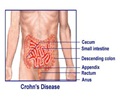A common but hard-to-see type of lesion in the colon poses a stronger threat of cancer than the more frequently diagnosed colorectal polyps, scientists said in a new study Wednesday.
Researchers in California found, using colonoscopy data from patients, that the often undetected flat lesions could be 10 times more risky for colon cancer than the polyp-shaped neoplasms which are usually the target of colonoscopies.With colon cancer the second leading cause of death by cancer in the United States, the discovery could push doctors to make greater efforts to detect and remove the flat lesions, called non-polypoid colorectal neoplasms (NP-CRNs).
"The current study emphasizes the importance of quality in the performance of colonoscopy," said David Lieberman of the Oregon Health and Science University, in a commentary on the research.
The current point of attack on colon cancer is to detect polyps and then remove them.
But Roy Soetikno and colleagues at the Veterans Affairs Palo Alto Health Care System in California said their examinations of data for 1,819 patients who underwent colonoscopies found that 9.35 percent had NP-CRNs, and that the NP-CRNs were far more often cancerous than polyp-shaped lesions, whatever the relative size.
"Overall, NP-CRNs were nearly 10 times more likely to contain cancerous tissue than polypoid lesions, irrespective of the size," a summary of their research said.
Advertisement
Lieberman added that more work needs to be done on the imaging from colonoscopies to better detect the NP-CRNs and to see whether patients with these types of lesions require more intense colonoscopic tests.
Advertisement
Source-AFP
SRM/L










